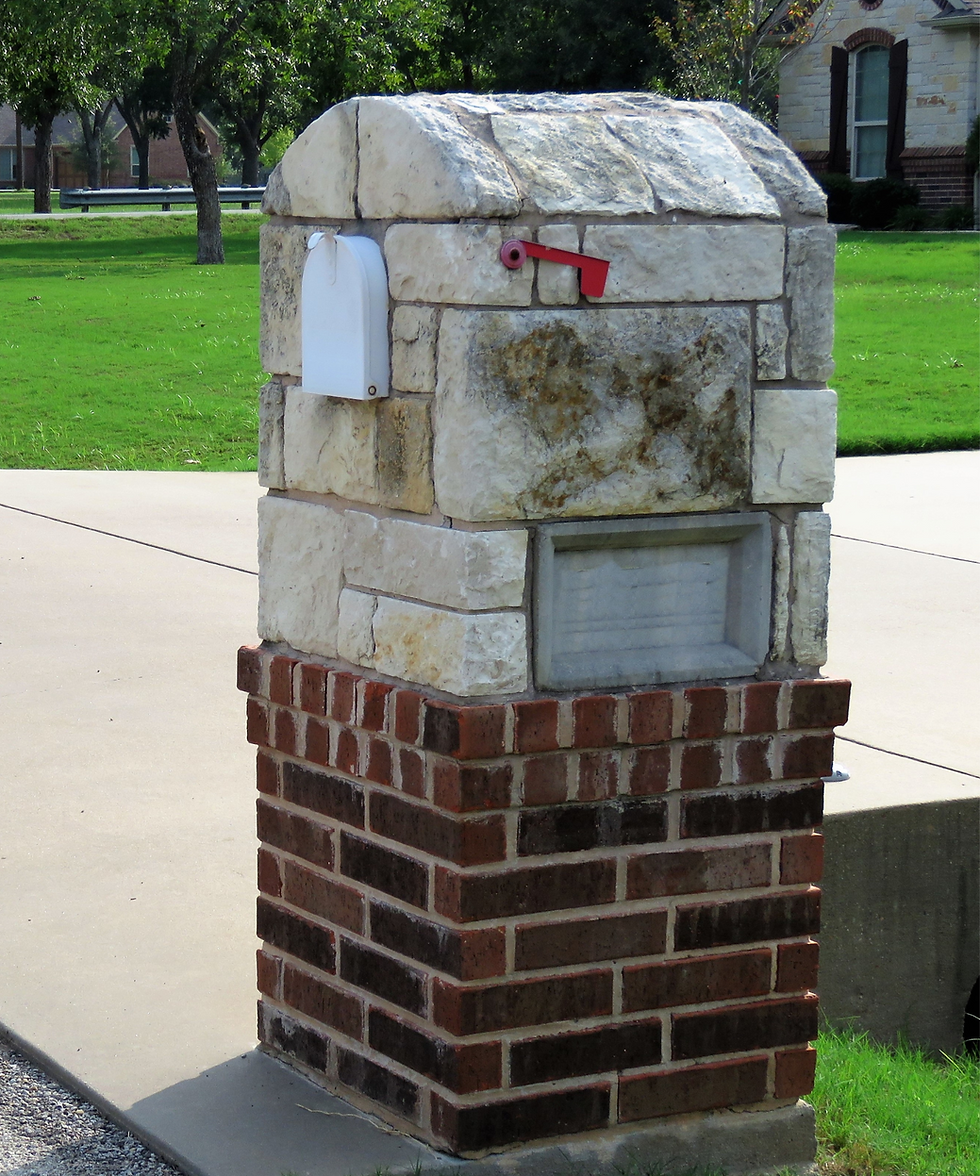The Different Types of Exterior House Stone
- srcustommasonry
- Oct 17
- 7 min read

There are several different types of exterior house stone to consider when working on a residential project. Stone isn’t just popular because of its aesthetic appeal; it’s also extremely durable and low-maintenance. The kind of exterior siding you choose for your home can make all the difference, so it’s worth doing some research to know what’s right for your unique home and budget.
Different Types of Exterior House Stone
Natural Stone
Natural stone for home exterior is as authentic as it gets, cut straight from the earth and full of color variations and texture. Popular choices include granite, limestone, sandstone, and fieldstone, each offering its own look and feel.
Natural stone is strong, fire-resistant, and virtually maintenance-free once installed. Because it’s so heavy and requires skilled labor, it’s also the most expensive option. Costs can range anywhere from $25 to $50 per square foot installed.
We’ll go over all the details of the most common and popular natural stone choices below:
Granite
Granite is one of those natural stones that is known for its strength and style. It’s formed deep within the earth, so every slab has its own mix of color, texture, and natural sparkle. While we’ve already talked about natural stone in general, granite deserves its own spotlight because it’s one of the most durable and eye-catching options out there. Homeowners love it for its solid, timeless feel, something that instantly makes any exterior look more high-end and permanent.
You’ll see granite used on everything from home facades and entryway pillars to retaining walls and outdoor kitchens. It holds up incredibly well in all kinds of weather. Heat, cold, rain, or snow don’t bother it one bit. That makes it especially great for places with big temperature swings or lots of sun exposure. Because of its density, it resists chips, cracks, and fading better than most other stones. Once it’s installed, it’s pretty much there to stay for life.
Pros of Granite
Extremely durable and long-lasting
Resists weather, fading, and damage
Adds a high-end, luxurious appearance
Cons of Granite
Higher material and installation costs
Heavy and harder to cut or shape
Limited color flexibility compared to manufactured options
Limestone
A limestone exterior has a soft, natural look with light shades of beige, cream, or gray. The surface usually has a matte or slightly chalky texture. You might notice faint fossil patterns or subtle color variations that make each piece unique. It’s not shiny like granite or rough like fieldstone. It has more of a balanced feel, giving the home more of a grounded look.
Limestone is usually cut into large rectangular blocks that line up neatly across the exterior, though smaller cuts can create a more traditional, brick-like pattern. Some homes use it for the full façade, while others mix it with stucco or wood for contrast.
Price-wise, limestone typically costs about $15 to $30 per square foot installed. Because it’s softer than stones like granite, it’s really important to have it installed by someone with a lot of experience.
Pros of Limestone
Timeless, natural appearance
Adds warmth and character to a home
Ages beautifully over time
Cons of Limestone
Softer and more prone to chipping
Requires sealing and occasional maintenance
Higher cost than some other stone options
Sandstone
Sandstone has a natural, earthy look with shades that range from tan and brown to red and gold. It often shows faint layers or color bands, giving it a little more texture and visual interest than smoother stones. The surface feels slightly rough, almost grainy, which makes it look casual and natural rather than polished or glossy.
It’s commonly used in warmer, dry areas like the Southwest and parts of the Midwest since it’s found naturally there. Most people use sandstone for exterior siding, porch columns, retaining walls, and entryway accents. It fits well on homes that lean rustic or traditional, but can also work for modern designs that want a touch of natural color.
In terms of cost, sandstone usually runs about $10 to $25 per square foot installed, which puts it close to limestone and lower than granite. It’s durable enough for most exterior projects, but since it’s a bit softer, it needs to be sealed occasionally to help it last.
Pros of Sandstone
Warm, natural colors that blend well with most home styles
Easy to shape and work with during installation
Moderate price compared to other natural stones
Cons of Sandstone
Softer and more porous than granite or slate
Needs sealing to protect from moisture and stains
Can fade or weather faster in harsh climates
Fieldstone
Fieldstone has a natural, rugged look. The stones come in all shapes and sizes, so no two walls ever look the same. You’ll see a mix of colors like gray, tan, brown, and sometimes a hint of red or green, depending on where the stone came from. When it’s put together, fieldstone creates a random, textured pattern that gives a home a lot of character and that cozy, lived-in feel people love.
Fieldstone usually costs around $15 to $35 per square foot installed,
depending on the size and how much work it takes to fit the pieces together. It’s heavier and takes more time to install than something like manufactured stone, but once it’s done, it’s built to last. Maintenance is pretty simple. It will typically include just a quick cleaning now and then and checking for any loose mortar. Over time, fieldstone actually tends to look better as it weathers, which is part of its charm.
Pros of Fieldstone
Natural, one-of-a-kind appearance
Very durable and long-lasting
Adds strong character and texture to a home
Cons of Fieldstone
More expensive and labor-intensive to install
Heavy, requiring solid structural support
Limited color control since each stone is unique
2. Manufactured Stone Veneer
Manufactured stone veneer is great because it offers the look of natural stone without the hefty cost or weight. It’s made from molded concrete, dyed to resemble real stone, and it can be surprisingly convincing once installed. Because it’s lightweight, it doesn’t need the same structural support as real stone. This makes it a popular choice for remodeling projects and accent walls.
It usually costs between $10 and $20 per square foot installed, which makes it far more budget-friendly than natural stone. You’ll often see it used around entryways, on fireplace surrounds, or halfway up an exterior wall paired with siding. It’s not quite as durable as natural stone and can fade a bit over decades, but for many homeowners, it strikes the perfect balance between style and affordability.
Pros of Manufactured Stone Veneer
Affordable
Lightweight
Versatile use
Wide variety
Consistent look
Easier installation
Cons of Manufactured Stone Veneer
Less durable than natural stone
Not ideal for all climates
Color fading
Less authentic
Can trap moisture
3. Natural Stone Veneer
Natural stone veneer gives you the look of real stone without all the weight that comes with full-sized pieces. It’s made by cutting thin slices from genuine stone, so you still get the unique colors, textures, and natural patterns that make stone so appealing. The difference is that veneer is much lighter and easier to work with, which makes it perfect for a wide range of exterior projects without needing special structural support.
You’ll see natural stone veneer used on home exteriors, outdoor fireplaces, entryways, and even columns or garden walls. Since it’s real stone, every piece has its own character, so no two homes look exactly alike.
In terms of cost, natural stone veneer usually falls between $10 and $25 per square foot installed. While it’s more expensive than manufactured stone veneer, it’s still more affordable than full-bed natural stone. The main difference, besides price, is weight and thickness. Full stone can be several inches thick and very heavy, while veneer is thinner and lighter, making it easier to install and more versatile for today’s homes.
Pros of Natural Stone Veneer
Real, authentic appearance
Durable and weather-resistant
Lighter and easier to install than full stone
Cons of Natural Stone Veneer
Higher cost than manufactured stone
Limited flexibility in cutting and shaping
Still heavier than synthetic options
Key Factors to Consider When Choosing Exterior Stone
1. Maintenance Needs
Different stones age and wear in their own way. Some, like granite, can go years with almost no upkeep, while others, such as limestone or sandstone, might need occasional sealing to protect against moisture and staining. Think about how much time you actually want to spend maintaining your home’s exterior before committing to certain kinds of stone.
2. Budget Considerations
Cost is always one of the biggest factors. Natural stone looks amazing but usually comes with a higher price tag, especially for materials like granite or full-bed fieldstone. Manufactured or veneer stone gives a similar look for less, making it a great option if you’re working within a tighter budget.
3. Climate Compatibility
Not every stone performs the same in every environment. Softer stones like limestone and sandstone can be more porous, which means they may not handle freeze-thaw cycles as well as harder stones.
4. Aesthetic Appeal
This part is all about your personal style and the look you’re going for. Consider your home’s architecture and environment, and what complements them best.
5. Weight and Installation
The heavier the stone, the more structure and support it needs. Full-thickness stone can look amazing, but it’s more challenging and expensive to install. Veneer stone offers a similar look at a fraction of the weight, making it easier to use on standard framing or accent walls without major structural changes.
The Different Types of Exterior House Stone: Conclusion
Choosing the right exterior stone for your home comes down to finding the balance between looks, durability, and practicality. The best choice is the one that fits your lifestyle and your long-term plans.
At S&R Masonry, we have years of experience helping homeowners across the Salt Lake City area find the perfect stone for their homes. We know what works best in Utah’s climate, and we bring years of experience in both design and installation. Whether you’re updating an entryway, redoing a façade, or starting fresh, we’ll help you choose materials that look great and stand the test of time.





Comments